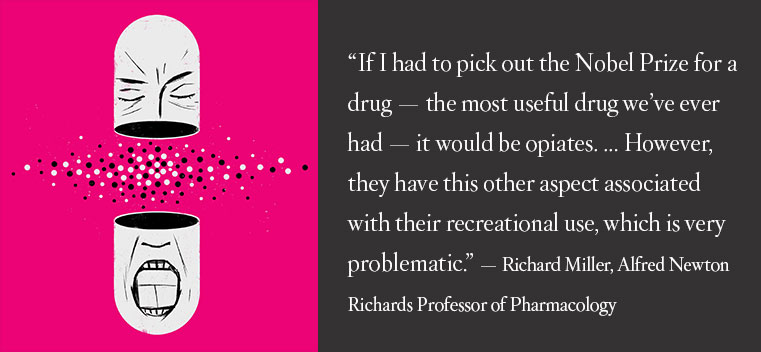
Ending the Opioid Epidemic
Tell us what you think. E-mail comments or questions to the editors at letters@northwestern.edu.
Find Us on Social Media
Scholars, medical practitioners and law enforcement agents gather at Northwestern to seek solutions to opioid crisis in the United States.
The numbers are simply staggering. Ninety-one people die every day from an opioid or heroin overdose. According to the Centers for Disease Control and Prevention, there were 33,000 overdose deaths due to prescription opioids and heroin in 2015.
The opioid epidemic has surpassed other recent public health crises, eclipsing the nearly 25,000 murders in 1991, at the height of the crack cocaine epidemic, and the estimated 26,000 drunk driving fatalities around 1981, said William Evans, Keough-Hesburgh Professor and Chair of the Department of Economics at the University of Notre Dame and one of the speakers at Northwestern’s fall 2016 interdisciplinary symposium on the opioid epidemic.
“Historically, over the last 120 years,” Evans added, “mortality rates have fallen precipitously in this country, but the increase in mortality from opioids is such that that trend has now been reversed for whites. ... Now for whites we’re seeing increasing mortality in these particular age groups [ages 25 to 34, 35 to 44 and 45 to 54], primarily driven by drug poisonings, of which opioids and heroin are the main culprits.”
The daylong symposium, held at the Northwestern Pritzker School of Law in late October, featured a keynote address from Sen. Dick Durbin and perspectives from 18 experts from across a range of fields — from physicians and addiction specialists to attorneys and law enforcement agents. It offered an opportunity to come together to search for creative alternative approaches and a holistic response to an urgent problem.
The overprescription of opioid pain relievers began in the 1990s. Since 1999 the number of opioid prescriptions has quadrupled, and now opioid pain relievers are the most prescribed class of medications in the United States, where more adults use prescription painkillers than use tobacco.
As some opioid painkillers became too expensive or harder to obtain for recreational use, thanks to crackdowns on so-called pill mills and lawsuits against pharmaceutical giants, some users moved to heroin, the cheaper and ever more accessible cousin to prescription opioids. Subsequently, heroin overdoses tripled from 2010 to 2014.
“If I had to pick out the Nobel Prize for a drug — the most useful drug we’ve ever had — it would be opiates,” explained Richard Miller, the Alfred Newton Richards Professor of Pharmacology at Northwestern, during the symposium’s opening panel. “Opiates are, generally speaking, the best drugs for treating pain.
“However, they have this other aspect associated with their recreational use, which is very problematic.” Opiates cause the brain to rewire itself, Miller explained, compelling the user to seek more and more, regardless of impediments.
David Neely ’85 GME, ’88 GME, an associate professor of general internal medicine and geriatrics who outlaws pharmaceutical reps from his medical office, talked about the difficulty of prescribing opioids responsibly. Narcotics, he said, are great for acute pain but problematic for chronic pain, and the transition from acute to chronic is often imperceptible. In his view, one of the hardest things he has to do is look a patient who is on chronic pain medication in the eye and say, “I’m reducing how much pain medicine you’re getting.”
He blamed pharmaceutical advertising and the Yelp-style reviews of the medical industry for the proliferation of prescriptions. “Americans think we should never be in pain,” Neely explained. When physicians and hospitals are graded on pain relief, patient satisfaction and likeliness to recommend, doctors are less likely to say no.
Shana Margolis ’08 GME, assistant professor of physical medicine and rehabilitation, said she’s found success providing interdisciplinary care for pain management — including physical therapy, occupational therapy and mind-body approaches — at the Rehabilitation Institute of Chicago. “My goal is to get patients in control of the pain again, and that means putting as many tools in their toolbox as I can to help them manage it,” she said.
On the law enforcement side, Lake County State’s Attorney Michael Nerheim discussed “A Way Out,” a program in his jurisdiction that allows anyone with an addiction to seek help at one of the county’s participating police stations without fear of arrest.
Juliet Sorensen, the Harry R. Horrow Professor in International Law and a co-organizer of the symposium series, ended the day with an appeal for continued conversation. “Coming out of the symposium,” Sorensen said later, “we got consistent feedback that it was unusual — and in my opinion too unusual — for these disciplines to be talking to each other, that it was very rare for a physician to be hearing from the special agent in charge of the DEA, for example, or for the U.S. attorney to be asked questions by social workers and addiction specialists. With that in mind, we are committed to continuing this dialogue.”



 Facebook
Facebook Twitter
Twitter Email
Email


